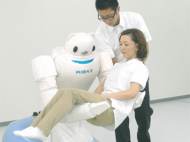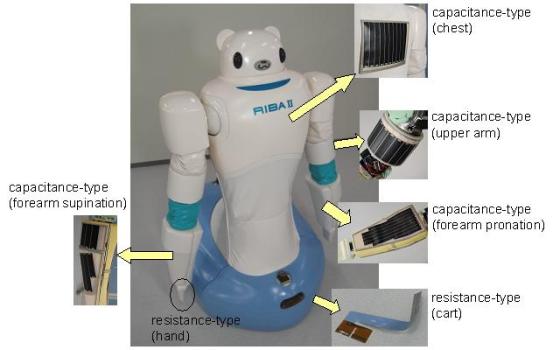RIBA II – improved robotic nursing care aid from Japan
 Japan has a growing number of elderly in need of nursing care and an urgent need for new approaches used to assist care-giving personnel. Researchers at RIKEN and Tokai Rubber Industries (TRI) are developing a robot which performs one of the most exhausting tasks for such personnel – lifting a patient from a futon at floor level into a wheelchair – which is carried out an average of 40 times every day.
Japan has a growing number of elderly in need of nursing care and an urgent need for new approaches used to assist care-giving personnel. Researchers at RIKEN and Tokai Rubber Industries (TRI) are developing a robot which performs one of the most exhausting tasks for such personnel – lifting a patient from a futon at floor level into a wheelchair – which is carried out an average of 40 times every day.
In 2009, the RIKEN-TRI Collaboration Center for Human-Interactive Robot Research (RTC), a joint project established in 2007 and located at the Nagoya Science Park in central Japan, unveiled Robot for Interactive Body Assistance (RIBA) designed to assist in this task. The first robot capable of lifting a patient from a bed to a wheelchair and back, RIBA charted a new course in the development of care-giving robots, yet functional limitations prevented its direct commercialization.
The new iteration, named RIBA-II, overcomes these limitations with added power and functionality. It is 137cm (4’6″) tall, 82cm (2’8″) wide and 103cm (3’4″) long. It weights nearly 230kg (500 pounds) and it’s equipped with high-precision tactile sensors and flexible motor control technology. Each arm has 7 degrees of freedom (DoF), its neck has 3 DoF, its waist has 2 DoF, and its omnidirectional base provides 3 DoF.
New joints in the robot’s base and lower back enable RIBA-II to crouch down and lift a patient of up to 80kg (176 pounds) in weight off a futon at floor level, one that RIBA was not able to do. RIBA-II accomplishes this task by using newly-developed Smart Rubber sensors – capacitance-type tactile sensors made entirely of rubber. Printed in sheets, the sensors enable high-precision tactile guidance and allow RIBA-II to quickly detect a person’s weight from touch alone, guaranteeing patient safety.
The capacitance-type Smart Rubber sensors in pronation of the forearms, the chest and the upper arms are used to measure the interaction forces between the health care patient and the robot. Those in the supination of the forearms and the upper arms are used to operate the robot. The resistance-type Smart Rubber sensors in the hand and on the cart surface are used to detect contact with care receivers or barriers.
It is capable to lift up or place down patients in beds, futons or wheelchairs. The robot can also move around autonomously after being programmed via a touch screen on its back. If it moves autonomously, the robot stops if it is near a barrier or if it is touched by a barrier. RIBA-II can be stopped or resumed by voice commands as well, and its vocal synthesizer enables it to perform preprogrammed greetings.
In the future, RTC researchers plan to partner with nursing care facilities in order to test RIBA-II and finely tune its capabilities to the needs of care-givers and their patients, while also developing new applications in areas such as rehabilitation. TRI aims to bring care-giving robots like RIBA-II to the market in the near future, promising support for aging populations in countries around the world.










author
There is a video with a demonstration of its features, but the author disabled embedding. You can watch it on YouTube.
According to Japanese Yahoo news, a commercial model should be ready by 2015 at a cost of 6,000,000 JPY ($77,000 USD).
Great. It will help old age patients very much. Certain medical duties are sensitive. Robot is expected to do the job.
Dr.A.Jagadeesh Nellore(AP),India
E-mail: anumakonda.jagadeesh@gmail.com
Well done Japan, another great invention